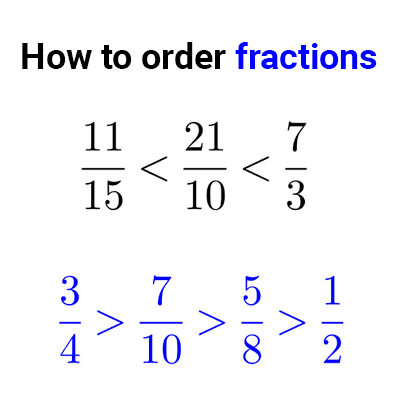
Fraction operations
In this article we explain operations with fractions: from basic arithmetic operations to power and radiccacion. We will see a complete guide with formulas, explanations, the rules for each operation and step-by-step examples.
Table of Contents
Addition of fractions
To add fractions with the same denominator (also called homogeneous fractions), you add the numerators and keep the same denominator.
*\dfrac{a}{b}+\dfrac{c}{b}=\dfrac{a+c}{b}*
Examples:
*\dfrac{18}{15}+\dfrac{19}{15}=\dfrac{18+19}{15}=\dfrac{37}{15}*
*\dfrac{28}{6}+\dfrac{14}{6}=\dfrac{28+14}{6}=\dfrac{42}{6}=7*
*\dfrac{2}{4}+\dfrac{8}{4}=\dfrac{2+8}{4}=\dfrac{10}{4}=\dfrac{5}{2}*
When working with fractions, it is convenient to simplify the resulting fraction as much as possible.
To add fractions with different denominators (also called heterogeneous fractions), you multiply the numerator of the first fraction by the denominator of the second and add it to the numerator of the first fraction, then place this result in the numerator. The denominator of the sum fraction is obtained by multiplying the denominators of the two fractions.
*\dfrac{a}{b}+\dfrac{c}{d}=\dfrac{ac+bc}{bd}*
Then, if necessary, simplify the result.
Examples:
*\dfrac{11}{5}+\dfrac{4}{7}=\dfrac{11\cdot 7+5\cdot 4}{5\cdot 7}=\dfrac{97}{35}*
*\dfrac{27}{8}+\dfrac{1}{2}=\dfrac{27\cdot 2+8\cdot 1}{8\cdot 2}=\dfrac{62}{16}=\dfrac{31}{8}*
The described method for solving this is known as the butterfly method for adding fractions.
Subtraction of fractions
To subtract fractions with the same denominator, you subtract the numerators and keep the same denominator.
*\dfrac{a}{b}-\dfrac{c}{b}=\dfrac{a-c}{b}*
Examples:
*\dfrac{8}{3}-\dfrac{7}{3}=\dfrac{8-7}{3}=\dfrac{1}{3}*
*\dfrac{1}{4}-\dfrac{2}{4}=\dfrac{1-2}{4}=-\dfrac{1}{4}*
To subtract fractions with different denominators, you multiply the numerator of the first fraction by the denominator of the second and subtract it from the numerator of the first fraction, then place this result in the numerator. The denominator of the subtracted fraction is obtained by multiplying the denominators of the two fractions.
*\dfrac{a}{b}-\dfrac{c}{d}=\dfrac{ac-bc}{bd}*
Examples:
*\dfrac{7}{6}-\dfrac{5}{12}=\dfrac{7\cdot 12-6\cdot 5}{6\cdot 12}=\dfrac{54}{72}=\dfrac{3}{4}*
*\dfrac{1}{3}-\dfrac{14}{5}=\dfrac{1\cdot 5-3\cdot 14}{3\cdot 5}=-\dfrac{37}{15}*
The process described for solving this is known as the butterfly method for subtracting fractions.
Multiplication (or product) of fractions
To multiply fractions, you multiply numerators with numerators and denominators with denominators.
*\dfrac{a}{b}\cdot \dfrac{c}{d}=\dfrac{a\cdot c}{b\cdot d}*
To multiply a fraction by a integer, you multiply the whole number by the numerator of the fraction.
*a\cdot \dfrac{b}{c}=\dfrac{a\cdot b}{c}*
Examples:
*\dfrac{2}{5}\cdot \dfrac{3}{4}=\dfrac{2\cdot 3}{5\cdot 4}=\dfrac{6}{20}=\dfrac{3}{10}*
*7\cdot \dfrac{3}{4}=\dfrac{7\cdot 3}{4}=\dfrac{21}{4}*
Division (or quotient) of fractions
To divide two fractions, you multiply the first fraction by the inverse of the second fraction, which is obtained by swapping the numerator and denominator.
*\dfrac{a}{b}:\dfrac{c}{d}=\dfrac{a}{b}\cdot \dfrac{d}{c}=\dfrac{a\cdot d}{b\cdot c}*
Examples:
*\dfrac{2}{7}:\dfrac{5}{4}=\dfrac{2}{7}\cdot \dfrac{4}{5}=\dfrac{2\cdot 4}{7\cdot 5}=\dfrac{8}{35}*
*-\dfrac{27}{5}:\dfrac{14}{2}=-\dfrac{27}{5}\cdot \dfrac{2}{14}=-\dfrac{27\cdot 2}{5\cdot 14}=-\dfrac{54}{70}=-\dfrac{27}{35}*
Fractions powering
To raise a fraction to a power, you raise both the numerator and denominator to that power.
*\left(\dfrac{a}{b}\right)^n=\dfrac{a^n}{b^n}*
Example:
*\left(\dfrac{2}{3}\right)^3=\dfrac{2^3}{3^3}=\dfrac{8}{27}*
If the power is negative, the numerator and denominator will switch places:
*\left(\dfrac{a}{b}\right)^{-n}=\left(\dfrac{b}{a}\right)^n=\dfrac{b^n}{a^n}*
Example:
*\left(\dfrac{7}{6}\right)^{-2}=\left(\dfrac{6}{7}\right)^2=\dfrac{6^2}{7^2}=\dfrac{36}{49}*
Fractions root
To calculate the root of a fraction, you calculate the root of the numerator and the root of the denominator.
*\sqrt[n]{\dfrac{a}{b}}=\dfrac{\sqrt[n]{a}}{\sqrt[n]{b}}*
Example:
*\sqrt[3]{\dfrac{8}{64}}=\dfrac{\sqrt[3]{8}}{\sqrt[3]{64}}=\dfrac{2}{4}=\dfrac{1}{2}*
Combined operations with fractions
It is possible to combine all or some of the operations in a single exercise. To solve it, it is important to know each individual case and the hierarchy to follow:
- Perform operations within parentheses and brackets, from the inside out.
- Solve powers and roots from left to right.
- Perform multiplications and divisions from left to right.
- Perform additions and subtractions from left to right.
Example:
*\left(\dfrac{2}{4}+\dfrac{1}{3}\right)^2-\sqrt{\dfrac{25}{49}}+\dfrac{2}{3}\cdot \dfrac{5}{8}-\dfrac{9}{2}:\dfrac{1}{2}=*
*=\left(\dfrac{5}{6}\right)^2-\dfrac{5}{7}+\dfrac{10}{24}-\dfrac{18}{2}=*
*=\dfrac{25}{36}-\dfrac{5}{7}+\dfrac{10}{24}-\dfrac{18}{2}=*
*=-\dfrac{542}{63}*
FAQs
What are the basic arithmetic operations on fractions?
The basic arithmetic operations with fractions are addition (+), subtraction (-), multiplication (x) and division (÷). In addition and subtraction it should be taken into account whether the fractions have the same or different denominator.
How to add fractions with unlike denominators?
To add fractions with unlike denominators, first find common denominators (least common multiple) and convert the fractions to equivalent fractions with that common denominator. Then the numerators are added and the common denominator is retained.
How to subtract fractions with unlike denominators?
Similar to addition, find common denominators and convert the fractions to equivalent with that common denominator. Then subtract the numerators and keep the common denominator.
How to multiply fractions?
The numerators are multiplied together to obtain the new numerator and the denominators are multiplied together to obtain the new denominator. The result is simplified if possible.
How to divide fractions?
The division of fractions is solved by multiplying the first fraction by the inverse of the second fraction. That is, the first fraction is multiplied by the reciprocal (inverse) fraction of the second fraction.

Other articles that may interest you